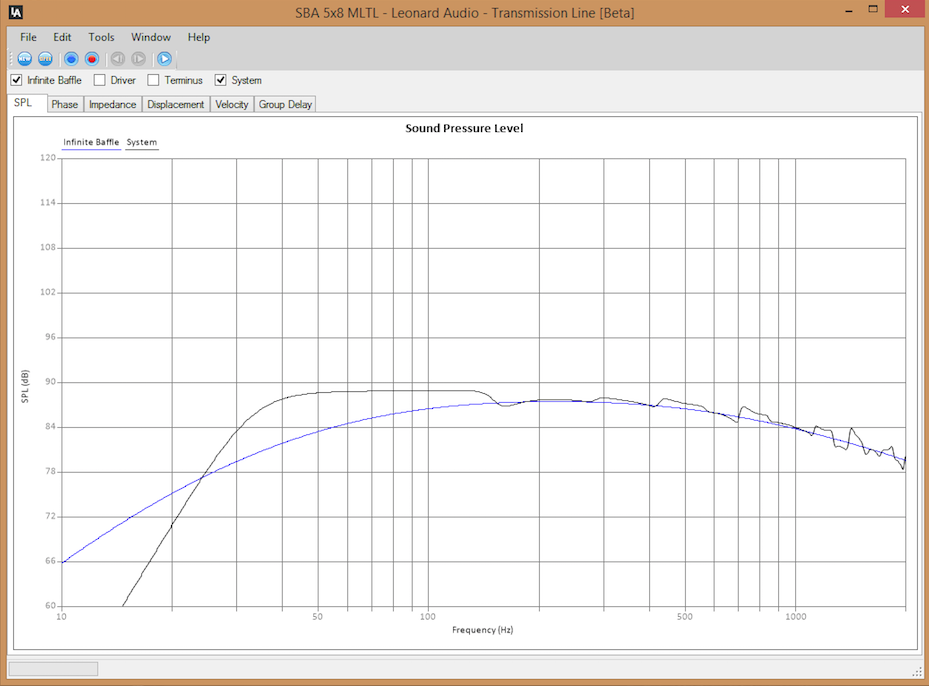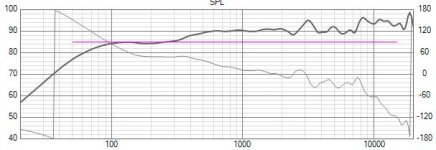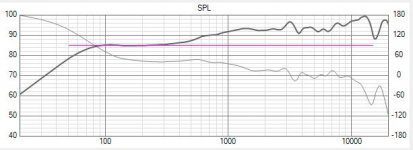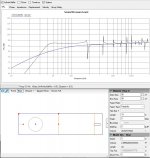Robin,
The modeler tells you what the effect of the TL is on the performance in the bass. Depending on where the roll-off is only pay attention to <250-400 Hz or so. Above that, the actual performance is all driver.
To estimate the response of the sytem you would have to either splice or somehow convolve the driver’s FR in the HF (250-400) with the model’s estimation at the LF below that.
dave
The modeler tells you what the effect of the TL is on the performance in the bass. Depending on where the roll-off is only pay attention to <250-400 Hz or so. Above that, the actual performance is all driver.
To estimate the response of the sytem you would have to either splice or somehow convolve the driver’s FR in the HF (250-400) with the model’s estimation at the LF below that.
dave
That high frequency roll-off is simulated from Le. Which is not accurate.
I would recommend smother low frequency roll-off as Perceval said.
I think straight will work better for this driver and it is easier to make.
I would recommend smother low frequency roll-off as Perceval said.
I think straight will work better for this driver and it is easier to make.
OK, back to the drawing table. Straight as in ML TL you mean? Would indeed be easier to build, as this will be my first diy build.
I have asked for advice on another forum as well and happily received similar outcome in quite the detail. I will try to replicate that first in LA and post the results.
@ Perceval (and others), is there anything in particular to dislike from this driver that you are aware off, except it's price?😉
Thanks again so far.
I have asked for advice on another forum as well and happily received similar outcome in quite the detail. I will try to replicate that first in LA and post the results.
@ Perceval (and others), is there anything in particular to dislike from this driver that you are aware off, except it's price?😉
Thanks again so far.
Yes. It actually looks like bass reflex.Straight as in ML TL you mean?
@ Perceval (and others), is there anything in particular to dislike from this driver that you are aware off, except it's price?😉
Thanks again so far.
I have zero confidence on the data offered by the company.
Unless they have found a way to circumvent the laws of physics regarding an 8" cone, I highly doubt the 30 and 60 degrees response are real world data.
8" should start beaming at about 2kHz... funny their graph is quite flat at 2kHz and above.
Perhaps it was measured 2cm from the cone, so even at 30 or 60 deg, you still are at 2cm! 😀
But if you do buy a pair, please measure for us.
If they are truly magical drivers that defy the laws of physics, then maybe they are worth the price. 🙂

I am with Perceval, and me too I don't want to rain on your parade. I am usually very wary of really expensive fullrange drivers... seems all of them are presented to the unsuspecting buyer pretty much the same way.
They usually make quite a bit of drama how their driver is absolutely unique, that they found special 'tricks' that no one has found or tried in the last 70 years, they employ eye candy in the way of chromed this and that etc. You get the idea.
When you can find a frequency response it is usually very stretched out in X and 'compressed' in Z... makes for a 'flat' response. There is no indication how the driver was measured (... I didn't look), but the response indicates an infinite baffle that will boost the bass region by as much as 6dB. Only you will not put your drivers in the wall of your living room.
All, and I mean all fullrange drivers with a wizzer cone have a rising response with local peaks due to break up modes and interference to some degree, and as Perceval pointed out every driver underlies the laws of physics. Which means that the 30 and 60 degree curves are bogus because especially the 30 degree usually looks a lot more jagged. Physics, not marketing.
Attached are a few responses that I happen to have... equally stretched out on purpose, and you will see the rising ersponse of all the them (not filtered of course), usually around 15 dB.
They usually make quite a bit of drama how their driver is absolutely unique, that they found special 'tricks' that no one has found or tried in the last 70 years, they employ eye candy in the way of chromed this and that etc. You get the idea.
When you can find a frequency response it is usually very stretched out in X and 'compressed' in Z... makes for a 'flat' response. There is no indication how the driver was measured (... I didn't look), but the response indicates an infinite baffle that will boost the bass region by as much as 6dB. Only you will not put your drivers in the wall of your living room.
All, and I mean all fullrange drivers with a wizzer cone have a rising response with local peaks due to break up modes and interference to some degree, and as Perceval pointed out every driver underlies the laws of physics. Which means that the 30 and 60 degree curves are bogus because especially the 30 degree usually looks a lot more jagged. Physics, not marketing.
Attached are a few responses that I happen to have... equally stretched out on purpose, and you will see the rising ersponse of all the them (not filtered of course), usually around 15 dB.
Attachments
Well, I am going to give it a thought for a while.. My original plan was to build onwards from this single driver,. So first in a tqwt/ ML TLand then after that I might try a SLOB build with this same driver.
Anyway, still trying to get a grip on LA. The advice I received is an MLTL of 9x10x40 inch. Driver 8 inch from top and port 4 inch from bottom, if I try to replicate it in LA, bass response is nowhere near the Martin King Mathcad modeled responses.
@planet10 I saw your post with the ML TL design for the cube audio "FC9" (assume it is a typo) which looks similar[emoji2]
Anyway, still trying to get a grip on LA. The advice I received is an MLTL of 9x10x40 inch. Driver 8 inch from top and port 4 inch from bottom, if I try to replicate it in LA, bass response is nowhere near the Martin King Mathcad modeled responses.
@planet10 I saw your post with the ML TL design for the cube audio "FC9" (assume it is a typo) which looks similar[emoji2]
It should be very similar to Martin King's Mathcads.
Maybe check, if everything is the same (driver parameters, ...).
Maybe check, if everything is the same (driver parameters, ...).
Yes, FC8, my typing is bad, having taken Grade 11 math instead of Grade 10 typing. At the time i thot i’d neve rneed to type, how wrong i was. :^)
dave
dave
I wish I did it the other way round [emoji6] still figuring out why my curve is still not similar. Looks like stuffing makes the difference, when I lower stuffing it seems to approach the same curve..
Yes, I think stuffing simulation is slightly different.
Compare it with no stuffing.
It is usually better to start without stuffing to reduce harmonics by changing dimensions (especially important for full range drivers).
When building speakers you can easily fine tune stuffing anyway.
Compare it with no stuffing.
It is usually better to start without stuffing to reduce harmonics by changing dimensions (especially important for full range drivers).
When building speakers you can easily fine tune stuffing anyway.
What can I do to make the model more representative?
BTW, I do not know if I go the right way about this in this thread or if I should be making a seperate one. Please do tell me if I should.
You can't since T/S theory peters out at the driver's [effective] upper mass corner and even then, it only shows a flat piston's response: Fhm = 2*Fs/Qts'.
Above this point the better programs can do pistonic polar plots, but any driver TL, breakup modes will modify it in ways that can't be predicted without significant actual measurements and the massive programming required to replicate it.
Qts' = Qts + any added series resistance [Rs]: HiFi Loudspeaker Design
Above this point the better calculators will include wide range response due to inductance [Le @ 1 kHz]: Fhvc = Re/[pi*Le], and a few that include thermal power distortion at higher power and at least one that includes lossy inductance options [Hornresp].
Seems to me it should be in the [Full Range] forum, but Dave hasn't moved it, so guess not.
GM
edit: Oops! Since I started this the other night I see I missed another 'page' of responses that has touched on all my points to some extent, so just adding a bit of tech to back it up.
Last edited:
This is the kind of curve I like to see when I try to design a TL.

Me too, regardless of the alignment type when well away from any large reflecting boundary
GM
Hi all,
I managed to get Leonard Audio TL software to work and started to model one of the DIY cabinets provided by Cube Audio for their FC8 driver.
Could any of you confirm if I am heading in the right direction?
Greets!
Did a quick sim in Hornresp
using your LATL alignment [not the folded drawing] that while quite rightly should have a parabolic expansion, the LATL is plotting the opposite [horn] flare even though the response plot is near enough identical, so assume it's this that's inverting TH sims: Transmission Line Modelling Software
Re [long term] 'right direction'; based on published specs and assuming effective Qt [Qts'] doesn't exceed ~0.62, then I too vote for a simple constant [straight] tapered MLTL or at least a 'Pensil' alignment.
GM
@ Perceval (and others), is there anything in particular to dislike from this driver that you are aware off, except it's price?😉
[Much] more compliance [Vas] to allow for larger cabs/greater efficiency/'effortless' sounding performance of the pioneer's drivers.
GM
Thanks GM! I am heading in that (straight ML TL) direction now.
As for the pioneers drivers with grater compliance (VAS), which are you referring to?
I guess higher efficiency is not necessary in my situation. I have a relatively small room and a 25w pass F6 to power them. And if I follow the advice calculated in MK Mathcad, 11 watt or 102db 1m is the maximum spl I can achieve with these drivers in the suggested enclosure.
As for the pioneers drivers with grater compliance (VAS), which are you referring to?
I guess higher efficiency is not necessary in my situation. I have a relatively small room and a 25w pass F6 to power them. And if I follow the advice calculated in MK Mathcad, 11 watt or 102db 1m is the maximum spl I can achieve with these drivers in the suggested enclosure.
Ok, I have tried a MLTL with dimensions 10"W x 9"D x 40"H. Port diameter and depth both 3" (Positioned 4 inch from bottom). Without stuffing I get the attached result. This looks like a much smoother "knee" right?
Indeed it do! 😉 But this one doesn't line up quite as well since HR plots 90 dB/~36 Hz Vs LATL's ~38 Hz plus the HF ripple is somewhat different, so combined with the sim's data, not sure you inputted it right, though been away from this program long enough to not be sure.
I mean you show the rear view, why? IIRC all that's needed is to just input the data in the front view.
What is the 19" length?
What is the 19.56+" shadowed in the Tap Pos. field?
GM
You're welcome!Thanks GM! I am heading in that (straight ML TL) direction now.
As for the pioneers drivers with grater compliance (VAS), which are you referring to?
I guess higher efficiency is not necessary in my situation. I have a relatively small room and a 25w pass F6 to power them. And if I follow the advice calculated in MK Mathcad, 11 watt or 102db 1m is the maximum spl I can achieve with these drivers in the suggested enclosure.
W.E., Lansing, Altec, JBL, EV, University, etc..
True, relatively speaking, but not the point! A good rule-of-thumb [ROT] is that if you can see it move, it's distorting. There's no such thing as too much efficiency/dynamic headroom when trying to extract the most from a recording, live performance, just a point of diminishing returns.
About 20 yrs ago, a local DIYer built some Fostex BLHs with a ~97 dB/m/stereo measured eff., but compared to my Altec's ~112 dB/14 ft/listening position, we could only hear his speakers with our ears up close when we switched wires due of course to the volume control being set so low.
Once adjusted to the same SPL, the Fostex were in deep distress on some passages, so couldn't play them as loud as the 'loafing along' Altec's.
GM
- Home
- Design & Build
- Software Tools
- Transmission Line Modelling Software



